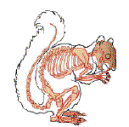
Billy Crudup and Samantha Morton in Jesus' Son (dir. Alison Maclean, 1999).

Billy Crudup and Jack Black.
Denis Johnson's 1992 book of short stories Jesus' Son not only leaves its narrator unnamed, but it leaves open to question whether this narrator is in fact the same from story to story. It's easy to see why so many readers assume it is. The voice throughout goes back and forth between various levels of heroin-addledness, which one can reasonably imagine as representing one person at different stages of deterioration or (partial) recovery. But it's never made explicit. This narrative structure is crucial to the book's power: the very notion of continuous identity is one of the commonplaces rendered unreliable or even moot by the destructive force of addiction. Similarly, even if we decide the speaker is the same, it's not clear that the order of the stories is chronological. They could well represent randomized memories of a life in irreparable disorder.
These are the main reasons that Alison Maclean's 1999 movie version utterly fails as a whole, despite the impressiveness of many of its parts. The decision to treat the book as a novel with an unequivocally consistent central character is disastrous (though it would have been equally disastrous to come down explicitly on the other possibility, that the characters are different, and it may be that the book is simply unfilmable). It's always a bad sign when a film adapted from a book relies heavily on voiceovers of speech lifted directly from the original text, and in this case the offense is particularly grave. Though probably no one could pull this off, Billy Crudup has no idea what to do with Johnson's gnomically elliptical prose. He tries to make it sound natural, even jaunty: big mistake. It's not natural, it's literary. It's not a script for performance, not a realistic facsimile of someone's interior monologue, but a deft superimposition of a pointed authorial sensibility onto characters who, if they were real, might well not even share much of that author's vocabulary. In the same way, the decision to render the discrete stories as a continuous arc of dramatic crisis eventuating in cathartic self-realization flattens out Johnson's far more challenging avoidance of obvious sequentiality.














